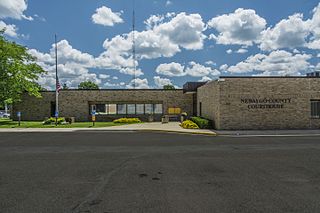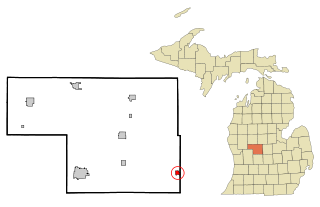
Newaygo County is a county in the U.S. state of Michigan. As of the 2020 United States Census, the population was 49,978. The county seat is White Cloud. The county was created in 1840, and was organized in 1851. It was either named for an Ojibwe leader who signed the Treaty of Saginaw in 1819 or for an Algonquian word meaning "much water".

Montcalm County is a county in the U.S. state of Michigan. As of the 2020 Census, the population was 66,614. The county is geographically located in the West Michigan region of the Lower Peninsula. The county seat is Stanton, and the largest city is Greenville. The county is named for General Marquis Louis-Joseph de Montcalm, military commander of French troops during the French and Indian War. The county was set off in 1831 and organized in 1850.

Mecosta County is a county located in the U.S. state of Michigan. As of the 2020 Census, the population was 39,714. The county seat is Big Rapids.

Ionia County is a county located in the U.S. state of Michigan. As of the 2020 census, the population was 66,804. The county seat is Ionia. The Ionia County Courthouse was designed by Claire Allen, a prominent southern Michigan architect.

Sand Lake is a village in Kent County in the U.S. state of Michigan. The population was 522 at the 2020 census.
Big Rapids Township is a charter township of Mecosta County in the U.S. state of Michigan. As of the 2020 census, the township population was 3,917.
Green Charter Township is a charter township of Mecosta County in the U.S. state of Michigan. As of the 2020 census, the township population was 3,219. The township was organized in 1858, before Mecosta County was detached from Newaygo County.

Carson City is a city in Montcalm County of the U.S. state of Michigan. The population was 1,120 at the 2020 census.

Greenville is a city in the Lower Peninsula of the U.S. state of Michigan. With a population 8,816 at the 2020 census, it is the largest city in Montcalm County. The city is the location of the establishment of the Meijer chain of stores.

Lakeview is a village in Cato Township in Montcalm County of the U.S. state of Michigan. The population was 1,024 at the 2020 census.
Montcalm Township is a civil township of Montcalm County in the U.S. state of Michigan. The population was 3,394 at the 2020 census, up from 3,350 in 2010.

Pierson is a village in Montcalm County of the U.S. state of Michigan. The population was 229 at the 2020 census, up from 172 in 2010. The village is within Pierson Township.
Pierson Township is a civil township of Montcalm County in the U.S. state of Michigan. The population was 3,363 at the 2020 census. The village of Pierson is located within the township.
Reynolds Township is a civil township of Montcalm County in the U.S. state of Michigan. The population was 5,431 at the 2020 census.

Stanton is a city in the U.S. state of Michigan. The population was 1,348 at the 2020 census. It is the county seat of Montcalm County.
Ensley Township is a civil township of Newaygo County in the U.S. state of Michigan. The population was 2,603 at the 2020 census.

Solon Township is a civil township of Kent County in the U.S. state of Michigan. The population was 6,496 at the 2020 census, a notable increase from 5,974 at the 2010 census.
Aetna Township is a civil township of Mecosta County in the U.S. state of Michigan. As of the 2020 census, the township population was 2,241.
Evergreen Township is a civil township of Montcalm County in the U.S. state of Michigan. The population was 2,941 at the 2020 census.
Tri County Area Schools is a school district headquartered in Sand Lake, Michigan. It serves sections of Kent, Montcalm, and Newaygo counties. It serves Sand Lake, Howard City, and Pierson as well as Pierson Township and Reynolds Township.












